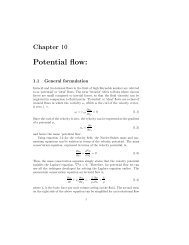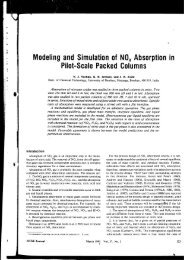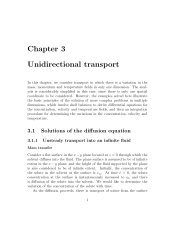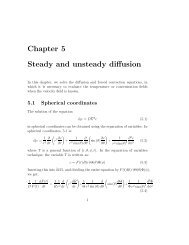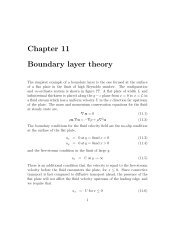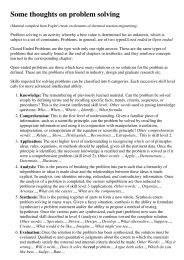You also want an ePaper? Increase the reach of your titles
YUMPU automatically turns print PDFs into web optimized ePapers that Google loves.
18 CHAPTER 9. VISCOUS FLOW<br />
Instead of having a discrete set of point forces, if we have a force distribution,<br />
in which the force per unit volume is given by f i (x), the velocity and pressure<br />
fields can be calculated by integrating the appropriate product of the Oseen<br />
tensor and the force distribution over the volume,<br />
∫<br />
u i (x) = dx ′ J ij (x − x ′ )f j (x ′ )<br />
∫<br />
p(x) = dx ′ K i (x − x ′ )F i (x ′ ) (9.71)<br />
9.2.2 Green’s function for force dipoles:<br />
There are often situations where the suspended particles in a fluid a ‘neutrally<br />
buoyant’, so that they exert no net force on the fluid. Examples are for a<br />
solid sphere in a uniform shear <strong>flow</strong> in equations and , and for a rotating<br />
particle in equations and . The velocity disturbance at a large distance<br />
from the center of the particle decays proportional to r −2 , in contrast to the<br />
decay proportional to r −1 in equation for the <strong>flow</strong> around a particle which<br />
exerts a net force on the fluid. The far-field velocity can be expressed as a<br />
function of the ‘force dipole moment’, which is defined as the integral over<br />
the sphere of the tensor product of the surface force and the position vector,<br />
∫<br />
Force dipole moment = dSx i f j<br />
∫<br />
= dSx i τ jk n k (9.72)<br />
Note that this definition is analogous to the ‘dipole moment’ for the temperature<br />
field due to a point dipole. The force dipole moment is a second<br />
order tensor, and it is convenient to separate it into a symmetric and an<br />
antisymmetric part. The symmetric part is given by,<br />
S ij = 1 ∫<br />
dS(x i τ jk n k + x j τ ik n k ) (9.73)<br />
2<br />
while the antisymmetric part is,<br />
A ij = 1 2<br />
∫<br />
dS(τ ik n k x j − τ jk n k x i ) (9.74)<br />
The velocity and pressure fields around a point particle which exerts no net<br />
force on the fluid can be expressed in terms of the symmetric and antisymmetric<br />
dipole moments S ij and A ij .





